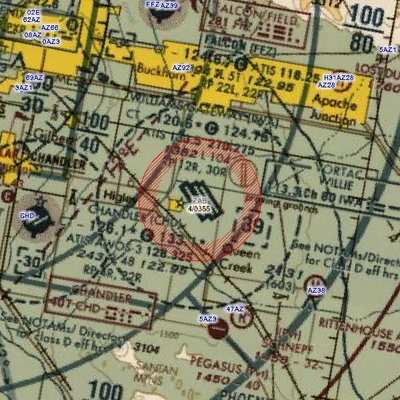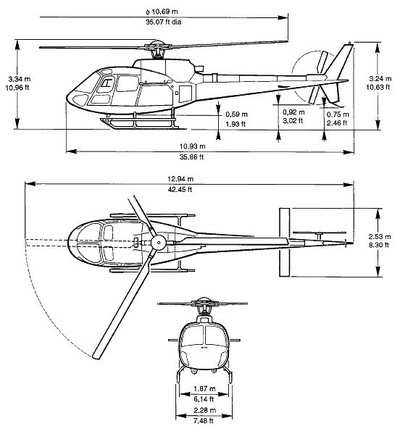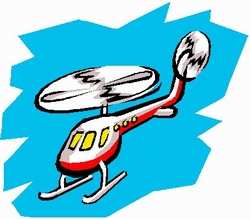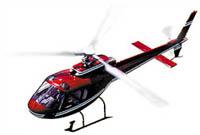Witnesses Say One Helo Maneuvered Into Second, Holding
Position
 The National Transportation Safety
Board released its preliminary findings this week regarding the
July 27 midair collision of two AS350 B2 television news
helicopters as they followed a police chase.
The National Transportation Safety
Board released its preliminary findings this week regarding the
July 27 midair collision of two AS350 B2 television news
helicopters as they followed a police chase.
In the Prelim -- which is presented, unedited, below -- the
Board says witnesses saw one of the helicopters -- belonging to
Channel 15 -- reposition, presumably to get a better angle as a
suspect on the ground abandoned his vehicle and commandeered
another one. This helicopter impacted a second helicopter, which
was relatively stationary.
A total of five news helicopters were in the area, covering
the high-speed chase.
On July 27, 2007, about 1246 mountain standard time, Channel 3
(CH 3) and Channel 15 (CH 15) News helicopters, N13TV and N215TV,
respectively, collided in mid air while maneuvering in Phoenix,
Arizona. Each helicopter was an American Eurocopter AS 350 B2. Mac
America Communications and US Helicopters, Inc., were operating the
helicopters under the provisions of 14 CFR Part 91. The commercial
pilots of both helicopters and one photojournalist in each
helicopter sustained fatal injuries. Ch 15 departed Scottsdale,
Arizona, at 1222, and CH 3 departed Scottsdale at 1232, as local
corporate flights. Visual meteorological conditions prevailed, and
no flight plans had been filed. The main wreckage for both
helicopters came to rest in a park about 75 feet from each
other.
Both helicopters were covering a police pursuit on local
streets. The suspect's vehicle had been moving, but he stopped,
abandoned it, and acquired another vehicle. The collision occurred
during this transition.
Another pilot indicated that there were five news helicopters in
the air at the time of the accident. He indicated that the accident
helicopters were positioned a reasonable distance apart when he
first noticed them. The police helicopter then broadcast that there
was going to be a car jacking. He stated that as a pilot, this
would indicate to him that he would have to change position. He
glanced away for a moment, and looked back to the accident
helicopters while flying toward them. He noted that they had moved
closer together. Shortly thereafter, they impacted. He could not
say for sure the relative position of each helicopter, but noted
that after the collision, CH 3 broke into many pieces. CH 15
remained in the air for a second, and then dove nose-first into the
ground.
Ground witnesses indicated that the CH 3 helicopter was
relatively stationary. The CH 15 helicopter was maneuvering when
the collision occurred. Upon impact, witnesses said that CH 3 broke
into many pieces and fell to the ground spinning. CH 15 remained
relatively intact except for the main rotor blades. It pointed nose
down and collided with the ground. There were no reports of erratic
movements prior to the collision, and no unusual sounds or
smoke.
A Phoenix Police Department helicopter pilot said that all
aircraft operated on the same frequency (123.025). The media would
operate a minimum of 500 feet above their altitude. In this case,
they entered Class B airspace, and contacted Phoenix Sky Harbor
(PHX) air traffic control tower (ATCT).
The ATCT and local helicopter operators established a new letter
of agreement (LOA), "Sharp Echo," on May 15, 2007. Its purpose was
to specify responsibilities, define terms, and establish procedures
to be used between Phoenix ATCT and signatory operators for the
control and operation of VFR and Special VFR helicopters within the
Phoenix Class B airspace. It changed ingress and egress to PHX, and
added transition routes (north/south and east/west) that protect
the final approach courses. All helicopters entering the airspace
squawked the same secondary beacon code of 0400 on their
transponders.

Use of "Sharp Echo" indicates a pilot's understanding of and
participation in this program. The pilots must state that they have
the current ATIS code (e.g. "I have information Bravo") or the
numbers. It states that helicopters should operate between 2,000
and 2,500 feet msl, north of Thomas Road while in the Class B
Airspace, unless otherwise required. The controller is not required
to provide separation to VFR helicopters in Class B airspace.
Other local pilots discussed local operating procedures. They
all maintained communication with each other on the same frequency,
and relied on maintaining separation by reporting their altitude
and position relative to a ground reference point.
A review of recorded radar data indicated multiple targets at a
mode C reported altitude of 2,100 feet msl; the accident site
elevation was 1,100 feet.
The debris field was almost 3,000 feet long. Pieces of blade
foam comprised most of the northern part of the debris field. A
couple of main rotor blade tips were to the south and southwest
about 700 feet from the main wreckage.

The main rotor blades for the AS 350 B2 rotate clockwise.
N13TV
The CH 3 helicopter had a primarily white cabin, transitioned to
orange along most of the tail boom, and the tail was yellow.
Airframe
Fire consumed most of the main fuselage section. The tail boom
section separated into several pieces.
The section of the tail boom forward of the tail rotor comprised
one section. It had clockwise crush damage. The forward right
section of the right horizontal stabilizer had a camera attached,
and separated in an upward direction. The aft section of the left
stabilizer separated, and was north of the main wreckage. It
exhibited accordion crush damage in an outward direction.
Investigators observed smeared zinc chromate primer transfer in a
clockwise direction on the upper center section of the tail boom
and horizontal stabilizer.
The aft tail boom comprised another piece. It exhibited a crush
mark on the left side that was upward and to the right.
The remainder of the tail section with the tail rotor attached
comprised a third major piece. The right side of the vertical fin
exhibited punctures with black rub marks. The front of this section
exhibited clockwise twisting with blue-gray paint and zinc chromate
primer transfer. One tail rotor exhibited a flattened strike tab
with chordwise scoring and orange paint transfer on the leading
edge. The airframe manufacturer's investigator noted indications of
flapping. The tail rotor drive shaft separated at the front end of
this separated section; the fracture surface was angular and
twisted. The tail rotor pitch change rod separated just forward of
the tail rotor bell crank input along a 45-degree angle.
Main Rotor Blades
Red Blade
 Charring encompassed the area 4 to
5 feet from the blade root. The blade portion aft of the spar from
approximately 11 feet out was missing. The blade sustained
mechanical damage and separation 14 to 15 feet from the blade root.
Investigators observed blue-gray and orange paint transfer marks on
the leading edge from about 12 feet out to the separation point.
The end plate and weights separated; investigators recovered them
several hundred feet north-northwest of the main wreckage.
Charring encompassed the area 4 to
5 feet from the blade root. The blade portion aft of the spar from
approximately 11 feet out was missing. The blade sustained
mechanical damage and separation 14 to 15 feet from the blade root.
Investigators observed blue-gray and orange paint transfer marks on
the leading edge from about 12 feet out to the separation point.
The end plate and weights separated; investigators recovered them
several hundred feet north-northwest of the main wreckage.
Blue Blade
Investigators observed significant mechanical damage 5 feet and
11 feet from the blade root, and the blade separated at these
points. The leading edge stainless steel strip was missing from 9
to 11 feet. The blade sustained thermal damage from the root out to
11 feet; there was no thermal damage on the outboard separated
pieces. The end plate was intact.
Yellow Blade
The blade portion aft of the spar was missing from 4 feet 4
inches and outboard. Investigators observed mechanical damage to
the leading edge 5 feet from the blade root, and the blade
separated at this point. The blade sustained mechanical damage 13
to 14 feet from the root. The 9- to 13-foot area sustained thermal
damage. The outer 1 1/5 feet of the blade, with the end plate
attached, separated; they found this piece on a parking garage
rooftop southwest of the main wreckage site. The outboard leading
edge of this piece sustained mechanical damage. The yellow Starflex
blade sleeve exhibited the most severe damage of the three
sleeves.
Engine
Post accident examination of the CH 3 engine revealed
substantial impact and post-impact fire damage. The axial
compressor ruptured from the gas generator between the intermediate
casing and the turbine casing assembly of the gas generator. The
axial rotor appeared solidly packed with mud and debris. The nose
bullet was in place, and appeared undamaged. The compressor case
and combustion chamber ruptured. The linking tube appeared
flattened. The short shaft separated from the triangular flange at
the rear of the turbine reduction gear; it exhibited torsional
twist. The short shaft exhibited rotational scarring aft of the
forward attach flange. The free turbine blades were in place, and
the tips of the leading edges appeared chipped and broken.
N215TV
The CH 15 helicopter was primarily dark blue along the top of
the cabin, tail boom, and tail; the lower part of the cabin was
yellow.
Airframe
Fire consumed most of the main wreckage.
Main Rotor Blades
Red Blade
 The leading edge sustained
mechanical damage 6 1/2 feet from the root; the blade separated at
this point. The blade section aft of the spar was missing from the
separation point to 12 feet 8 inches from the root. The leading
edge stainless steel strip was also missing from this area. The
blade portion outboard of 12 feet 8 inches separated; it hit a
delivery truck and came to rest in a parking lot southwest of the
main wreckage. The endplate was intact.
The leading edge sustained
mechanical damage 6 1/2 feet from the root; the blade separated at
this point. The blade section aft of the spar was missing from the
separation point to 12 feet 8 inches from the root. The leading
edge stainless steel strip was also missing from this area. The
blade portion outboard of 12 feet 8 inches separated; it hit a
delivery truck and came to rest in a parking lot southwest of the
main wreckage. The endplate was intact.
Blue Blade
The leading edge sustained mechanical damage and separated 4
feet 8 inches from the root. The inboard sections of the blade
sustained thermal damage. Large sections of blade skin and foam
core were missing. Investigators observed leading edge mechanical
damage and forward bending from 9 feet 7 inches to 12 10 inches.
One piece from this area separated; it was inside the park
boundaries south of the main wreckage.
Yellow Blade
The blade sustained thermal damage from the root out to 8 feet 9
inches. Investigators observed severe mechanical damage and
separation from 8 feet 9 inches to 11 feet 9 inches. A piece of
blade from this area exhibited a semicircular impression with
dimensions similar to a main rotor blade. There were blue-gray
paint transfer marks along the leading edge. The blade section 11
feet 9 inches and outboard separated; the end plate was
present.
Engine
Post accident examination of the CH 15 engine revealed
substantial impact and post-crash fire damage. The axial rotor
blades appeared bent in a direction opposite the direction of
rotation. The nose bullet appeared flattened and smeared in a
direction opposite that of rotation. The coupling tube between the
engine and main rotor transmission ruptured; it exhibited torsional
twist. The linking tube was twisted. The transmission shaft
ruptured, and exhibited torsional twist. The short shaft separated
from the triangular flange at the rear of the turbine reduction
gear, and twisted; however, it remained connected to the triangular
flange by a portion of the flexible coupling. The free turbine
blades were in place, and appeared undamaged.
Federal Aviation Regulations (FAR)
FAR 91.111 addresses operating near other aircraft. It states in
part that no person may operate an aircraft so close to another
aircraft as to create a collision hazard. FAR 91.113 states in part
that vigilance shall be maintained by each person operating an
aircraft so as to see and avoid other aircraft.
Advisory Circular (AC) 90-48C Pilots' Role in Collision
Avoidance
According to AC 90-48C, "...the flight rules prescribed in Part
91 of the Federal Aviation Regulations (FARs) set forth the concept
of "See and Avoid." This concept requires that vigilance shall be
maintained at all times, by each person operating an aircraft,
regardless of whether the operation is conducted under Instrument
Flight Rules (IFR) or Visual Flight Rules (VFR).
"Pilots should also keep in mind their responsibility for
continuously maintaining a vigilant lookout regardless of the type
of aircraft being flown. Remember that most MAC [mid-air collision]
accidents and reported MAC [near mid-air collisions] occur during
good VFR weather conditions and during the hours of daylight."
The AC further states, "pilots should remain constantly alert to
all traffic movement within their field of vision as well as
periodically scan the entire visual field outside of their aircraft
to ensure detection of conflicting traffic. The probability of
spotting a potential collision threat increases with the time spent
looking outside, but certain techniques may be used to increase the
effectiveness of the scan time. The human eyes tend to focus
somewhere, even in a featureless sky. In order to be most
effective, the pilot should shift glances and refocus at intervals.
Pilots should also realize that their eyes may require several
seconds to refocus when switching views between items in the
cockpit and distance objects. Peripheral vision can be most useful
in spotting collision threats from other aircraft. Pilots are
reminded of the requirements to move one's head in order to search
around the physical obstructions, such as door and window
posts."
 ANN's Daily Aero-Linx (04.15.24)
ANN's Daily Aero-Linx (04.15.24) Classic Aero-TV: 'No Other Options' -- The Israeli Air Force's Danny Shapira
Classic Aero-TV: 'No Other Options' -- The Israeli Air Force's Danny Shapira Aero-News: Quote of the Day (04.15.24)
Aero-News: Quote of the Day (04.15.24) Airborne 04.16.24: RV Update, Affordable Flying Expo, Diamond Lil
Airborne 04.16.24: RV Update, Affordable Flying Expo, Diamond Lil ANN's Daily Aero-Term (04.16.24): Chart Supplement US
ANN's Daily Aero-Term (04.16.24): Chart Supplement US







